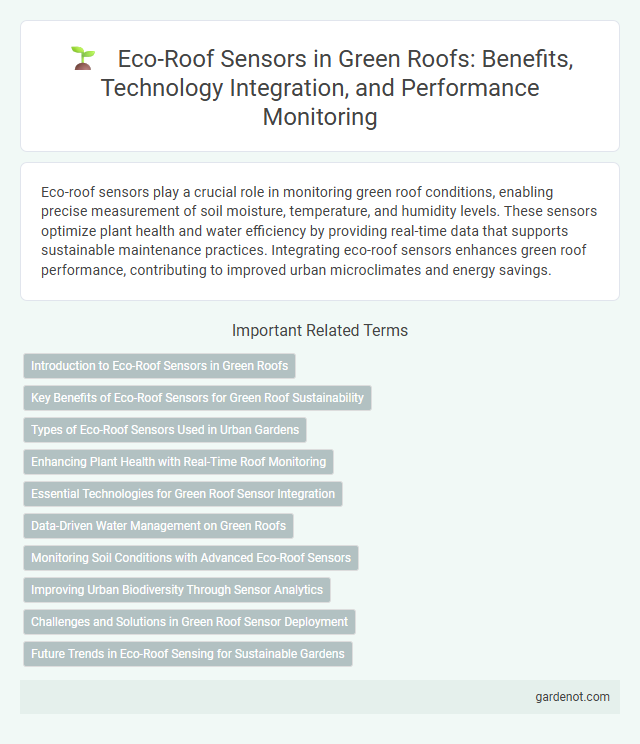Eco-roof sensors play a crucial role in monitoring green roof conditions, enabling precise measurement of soil moisture, temperature, and humidity levels. These sensors optimize plant health and water efficiency by providing real-time data that supports sustainable maintenance practices. Integrating eco-roof sensors enhances green roof performance, contributing to improved urban microclimates and energy savings.
Introduction to Eco-Roof Sensors in Green Roofs
Eco-roof sensors monitor critical environmental parameters such as soil moisture, temperature, and humidity on green roofs to optimize plant health and water usage. These sensors provide real-time data that supports efficient irrigation management and enhances the sustainability of urban green infrastructure. Integrating eco-roof sensors into green roofs helps reduce energy costs and promotes healthier plant growth through precise environmental control.
Key Benefits of Eco-Roof Sensors for Green Roof Sustainability
Eco-roof sensors provide real-time monitoring of moisture levels, temperature, and solar radiation, ensuring optimal plant health and water efficiency in green roofs. These sensors enable precise irrigation management, reducing water waste and promoting sustainable water use. By enhancing data-driven decision-making, eco-roof sensors extend the lifespan of green roof systems and contribute significantly to urban environmental resilience.
Types of Eco-Roof Sensors Used in Urban Gardens
Eco-roof sensors in urban gardens primarily include moisture sensors, temperature sensors, and solar radiation sensors, each playing a critical role in monitoring the health and efficiency of green roofs. Moisture sensors measure soil water content to optimize irrigation schedules, while temperature sensors track surface and ambient temperatures to protect plant health and energy performance. Solar radiation sensors assess sunlight exposure, aiding in the evaluation of photosynthesis rates and shading effects, thus ensuring sustainable urban garden management.
Enhancing Plant Health with Real-Time Roof Monitoring
Eco-roof sensors provide real-time data on moisture levels, temperature, and sunlight exposure, enabling precise adjustments to optimize plant health on green roofs. These advanced monitoring systems detect early signs of plant stress and environmental fluctuations, reducing maintenance costs and improving vegetation longevity. Integrating eco-roof sensors supports sustainable urban ecosystems by promoting efficient water usage and enhanced plant growth.
Essential Technologies for Green Roof Sensor Integration
Eco-roof sensors utilize essential technologies such as moisture sensors, temperature probes, and solar radiation detectors to optimize green roof performance. These integrated systems provide real-time data that enhances water management, energy efficiency, and plant health monitoring. Advanced wireless connectivity and IoT platforms enable seamless data transmission, supporting sustainable urban landscape maintenance.
Data-Driven Water Management on Green Roofs
Eco-roof sensors enable precise data-driven water management on green roofs by continuously monitoring soil moisture, temperature, and humidity levels. This real-time data optimizes irrigation schedules, reduces water waste, and enhances plant health, contributing to sustainable urban environments. Integrating these sensors with automated irrigation systems promotes efficient water use and supports green infrastructure resilience.
Monitoring Soil Conditions with Advanced Eco-Roof Sensors
Eco-roof sensors utilize advanced technology to monitor soil moisture, temperature, and nutrient levels in real time, enhancing the health and sustainability of green roofs. These sensors provide precise data that help optimize irrigation schedules, prevent overwatering, and reduce water waste. Integrating eco-roof sensors promotes plant vitality and extends the lifespan of green roof systems through efficient soil condition management.
Improving Urban Biodiversity Through Sensor Analytics
Eco-roof sensors monitor microclimatic conditions and soil moisture levels on green roofs, providing real-time data that enhances plant health and diversity. Sensor analytics enable precise irrigation and maintenance schedules, creating optimal habitats for pollinators and urban wildlife. Integrating this technology supports urban biodiversity by promoting resilient ecosystems within city environments.
Challenges and Solutions in Green Roof Sensor Deployment
Green roof sensor deployment faces challenges such as harsh environmental conditions, sensor durability, and data accuracy due to variability in moisture, temperature, and sunlight. Solutions include using robust, weather-resistant sensors with self-calibration features and wireless communication to ensure reliable data collection. Integrating IoT technology allows real-time monitoring, improving green roof maintenance and optimizing plant health management.
Future Trends in Eco-Roof Sensing for Sustainable Gardens
Eco-roof sensors are advancing with integrated AI algorithms that optimize water usage and monitor microclimate conditions to enhance plant health and energy efficiency. Future trends include real-time data analytics combined with IoT connectivity for precise environmental adjustments and predictive maintenance of green roofs. Emerging sensor technologies aim to support sustainability by reducing resource waste and improving biodiversity in urban garden ecosystems.
Eco-roof sensor Infographic

 gardenot.com
gardenot.com